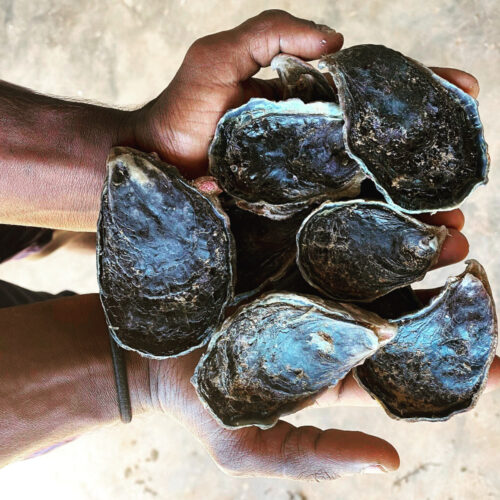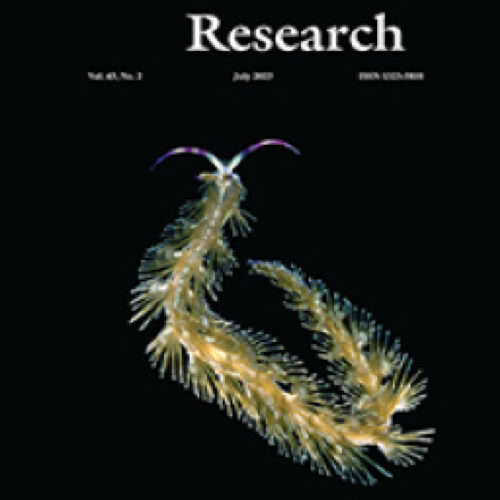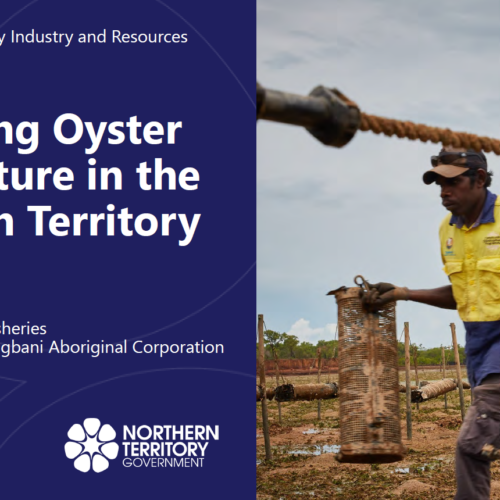
- Reference # A.2.1819053NT
- Project Status Current
- Timeframe 4 years (2019 to 2023)
- Project manager Sarah Docherty
- CRCNA Funding $1,200,000
- Total project value $4,124,090
- Project research participant Northern Territory Department of Industry, Tourism and Trade (NT DITT) ; DigsFish Services ; Yagbani Aboriginal Corporation ; Anindilyakwa Land Council
- Research Programs 2. New and developing industries in Northern Australia
- Location Dampier, Cone Bay, Perth, Darwin, South Goulburn Island ( Warruwi), Groote Eylandt ( Alyangula), Townsville.
- Aquaculture
- First Nations led business development
Summary
This project establishes a collaborative cross-jurisdictional approach to address the most significant technical and regulatory issues which are confronting northern Australia’s fledgling Tropical Rock Oyster (TRO) industry.
The project work will be conducted by research teams in Western Australia (A.2.1819053WA) and the Northern Territory and include three sub-projects addressing the different research needs identified. These are outlined below.
Sub-Project 1 – Species Identification, Pathogen Screening and Translocation Risk assessment (NT)
This research will standardise oyster common names and assess the need for farming and translocation zones across NA. It will consider risks associated with genetic pollution of wild populations, existing information on tropical ecosystems and oyster diseases, experiences from the pearl industry, and existing practice in edible oyster aquaculture in other regions of Australia. This information will provide a strong science base for biosecurity planning, management and operating procedures for the developing industry and determine key issues for further research and development.
Sub-Project 2 – Securing commercial spat (juvenile) supply
Early hatchery development work in the NT and WA indicates Tropical Rock Oysters have different larval requirements to the well-studied and already commercially produced Sydney Rock Oyster (SRO) and Pacific Oyster (PO). Therefore, the hatchery manuals developed for SRO’s and PO’s are not effective in producing commercial quantities of TRO spat.
Researchers will utilise existing hatchery infrastructure and expertise at the Darwin Aquaculture Centre to refine culture techniques for the Blacklip Rock Oyster.
Hatchery trials will be conducted to refine and improve larval settlement procedures and will include experiments on different salinities, the timing of settlement and the effectiveness of chemical and substrate settlement cues. Work on conditioning broodstock within the hatchery and investigating which hatchery systems work best will also form part of this sub-project
Sub-Project 3 – Optimisation of grow-out methods and gear technology
This Sub-Project will investigate optimised grow-out methods and gear technology for the production of Blacklip Rock Oyster. Farming trials will be conducted using intertidal systems at two sites: South Goulburn Island (supported by the Yagbani Aboriginal Corporation) and Groote Eylandt ( supported by the Anindilyakwa Land Council). The two trials will include:
- Trial 1 will use one manufacturer type to investigate the effect of three different basket heights in the tidal range (standard, low and dynamic) and density (standard and half of standard) of oysters in baskets on growth and survival of oysters and the biofouling of the baskets. Growth rates, shell shape, survival and biofouling will be recorded.
- Trial 2 will compare the performance of different gear types in producing marketable Blacklip Rock Oysters. This trial will provide data on oyster growth and shape and qualitative information on the operation, maintenance and performance of the different systems.
Expected outcomes
- A new aquaculture sector for Northern Australia employing at least 500 people would result in a direct increase in output for NA of $217.714 million.
- Expected impacts to the Tropical rock oyster industry’s total output would be $351 million.
- Biosecurity and translocation risks are clearly defined and managed through clear and targeted policies and regulations. Mitigating potential negative effects of large-scale oyster culture on wild stocks (genetics and health).
- Government, industry and consumers recognise and are able to differentiate between the different oysters being produced across NA. Preventing potential market confusion and ensure accurate licencing and management of the emerging industry.
- Hatcheries are able to reliably produce commercial quantities of Black-lip Rock Oyster (S. echinata) spat.
- Hatcheries are able to condition and spawn broodstock year-round.
- Increased oyster production due to the availability of spat.
- Improved oyster growth and survival.
- Increased confidence for industry investors and proponents, including Aboriginal communities in the development and sustainable growth of commercial aquaculture businesses.
- Increased capacity within Aboriginal partners to participate in the emerging industry.
Publications
4 July 2023
Assessment of blacklip rock oyster, Saccostrea lineage J, spat growth and survival in recirculating upweller and downweller nursery systems
Type:
Industry: Aquaculture
1 February 2022
Hatchery Protocol for the Blacklip Rock Oyster Saccostrea echinata (Quoy and Gaimard, 1835)
Type: Report
Industry: Aquaculture
13 November 2019
Expanding oyster aquaculture in the Northern Territory
Type: Presentations
Industry: Aquaculture, First Nations led business development, Strategic policy development, Supply chain development




